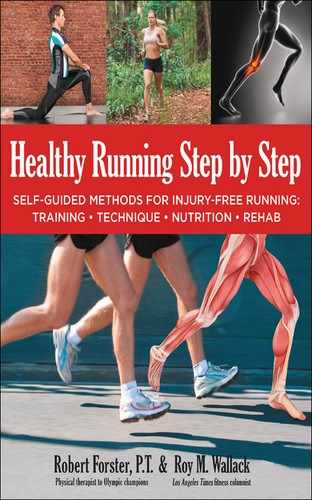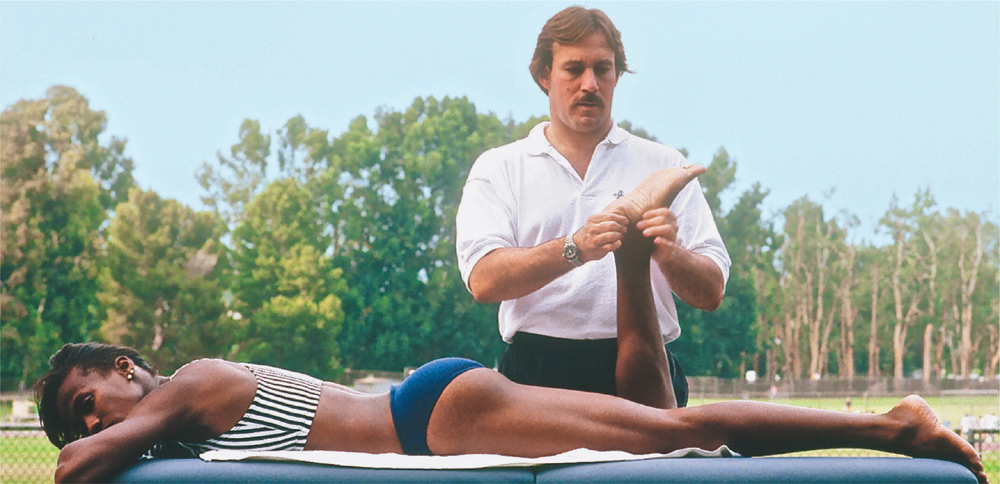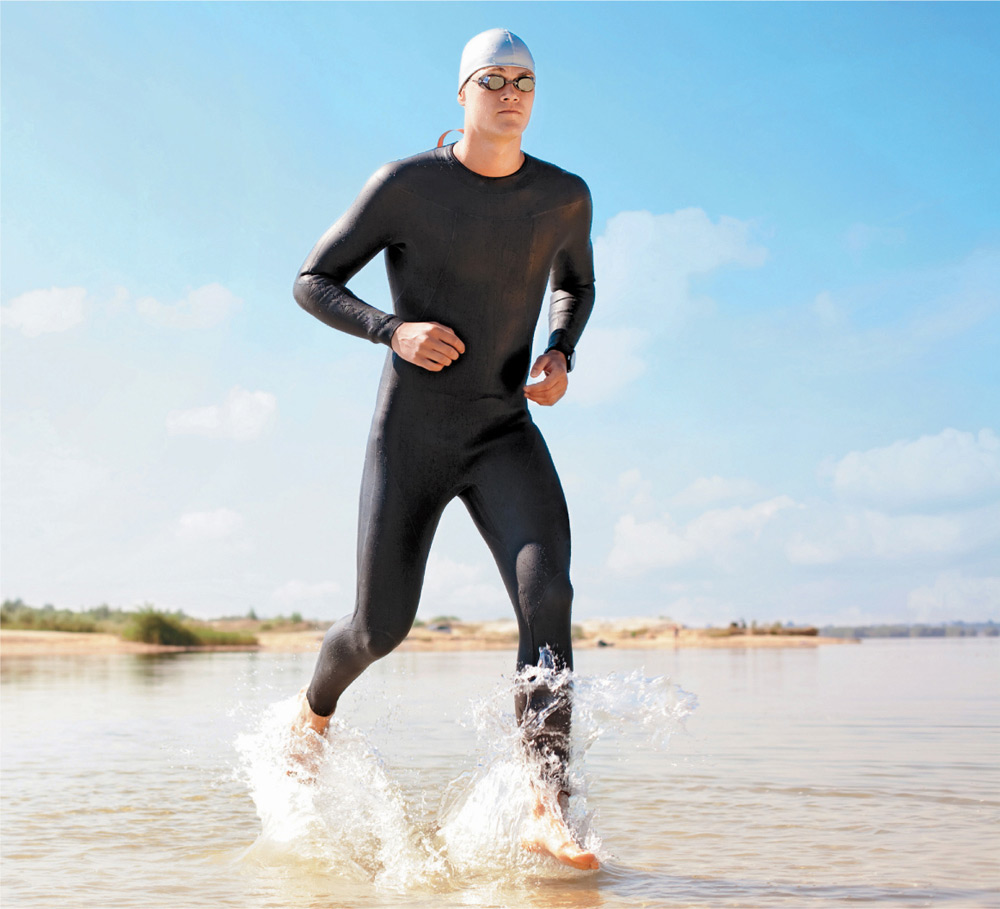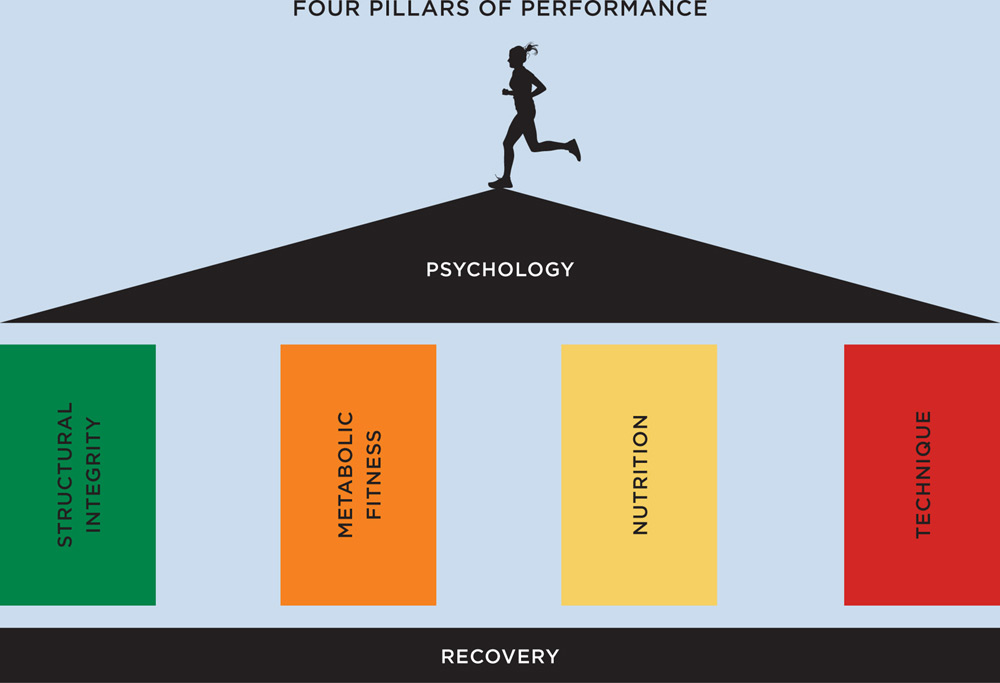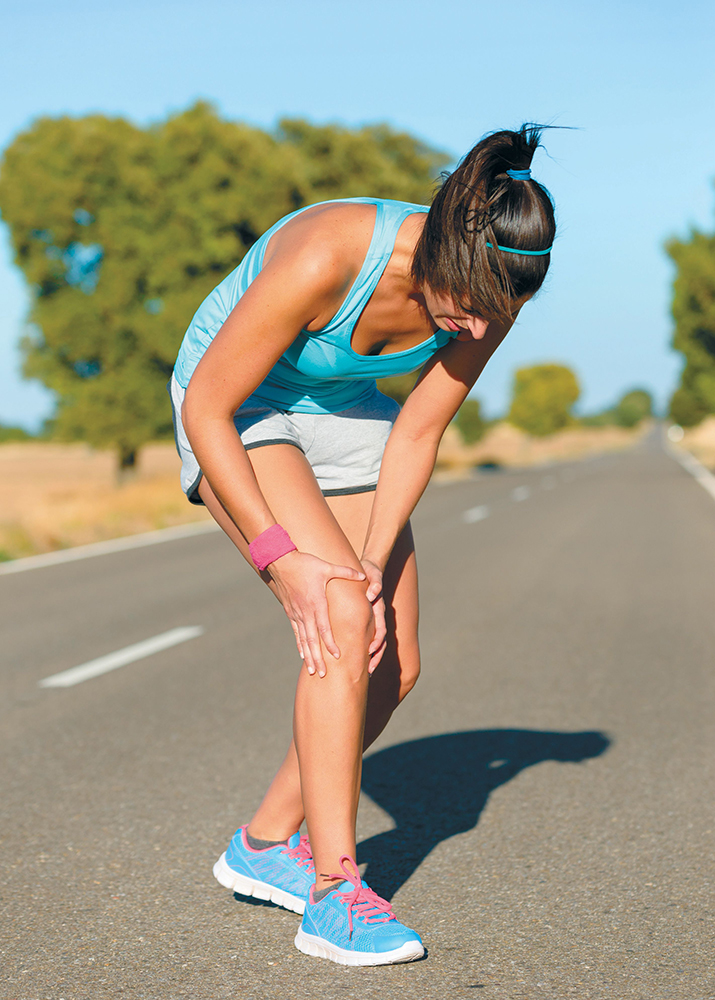
1 Why Runners Get Hurt
Injuries are inevitable due to overuse, lack of recovery, poor diet, lousy form, and failure to shore up your infrastructure and create a fat-burning engine. Here, Bob Forster explains how to keep your running safe.
One of the most basic rules of sports medicine is, “You need 2 days off from running for every day that you’ve run in pain.” So if you’ve felt some pain for a week, then you should not run for 2 weeks. If all you remember from this book is that rule, you might add decades to your running career.
It became clear to me in my first years as a physical therapist that most running injuries are actually overuse injuries, and they take a long time to develop. It’s much easier to understand and treat an acute injury. But repetitive motion injuries that create inflammation (discussed in “The Anatomy of Overtraining Injuries” on pages 22–23) and accumulate scar tissue over months and years can’t be addressed with a quick fix. It doesn’t matter whether you’re an elite runner or a back-of-the-packer—you have probably ignored an injury for way too long, to your detriment.
In 1978, when I first began treating runners, they were seen as an enigmatic group of loners who spent hours of solitude slogging through longer and longer workouts. Finding solitude became harder as millions more laced up running shoes over the years, motivated by the health benefits of regular exercise and the simplicity and economy of the sport. After all, running was easy and required little investment in goods or coaching. Everyone already “knew” how to run: just like they did as kids.
After a few years, the exhilaration that comes with the repetitive cyclic motion of running was identified as the runner’s high. The exhilaration was also tied to the release of morphine-like chemicals in the brain called endorphins. Runners didn’t really understand endorphins, but they knew they made them feel good. Before long, millions of runners were hooked. They ran every day, through rain and cold and even snow.
Back then no one knew how to stretch—or how to buy shoes. There were only a few brands on the market with limited choices. They didn’t know pronation from supination or why it mattered. Their social group outside running shrank down in size because their friends thought they were a bit crazy, and their spouses and family felt left out—but none of this stopped runners from running. They defended their fanatical dedication to running by citing literature that promised near immortality from the cardiovascular health benefits of aerobic exercise. Hard-core runners, so caught up in their addictive overtraining, seemed to believe that one missed day of running would clog their arteries overnight and they would die of heart disease.
It was therefore inevitable that the only thing that would stop obsessed runners who did not yet know that too much of a good thing is bad would be injury. By the mid-’80s, too many runners landed in my physical therapy office in Santa Monica with severe and debilitating injuries. Why? Because they ran too much, too often, and too far. They came in the office with bags of running shoes whose wear pattern they hoped would provide an answer to their chronic injury pattern. In an attempt to manage the fanatical allegiance to their sport, many doctors were reluctant to tell runners to stop running. It was the ignorant leading the obsessed; soon, shin splints turned into stress fractures, heel bones grew bone spurs, and running through injuries caused irreversibly damaged tendons.
I know this firsthand because I became one of them. As a former college wrestler from New York who needed to find a transition sport to feed my need to stay fit, the sun-drenched bike path along Santa Monica beach was too alluring to avoid falling prey to the running obsession.
Robert Forster, P.T., working on three-time Olympic gold medalist Jackie Joyner-Kersee before the 1992 Olympics.
Only months after beginning to run, I built my mileage up to marathon-training volume and I unwisely ran two marathons in the first year. I was hooked now, too. Even as a freshly minted physical therapist who knew better, I couldn’t keep myself from running through pain. Suffering chronic shin splints, I applied physical therapy treatment to my aching legs and did exercises to strengthen the sore tendons to the point where I could move a small house with my ankle inverters. I even got fitted for orthotic devices in my shoes. But still the pain persisted, because my vision was too limited.
Although we clinicians were proficient at identifying common running injuries, the focus of clinical treatment remained reactive and not proactive. The treatment for foot or leg injuries was orthotic devices or an exercise or two in an attempt to strengthen the overburdened tendons. The problem was that the source of the injury, which can be remote from the painful area, was not addressed.
At the same time I was working with one of the most successful running coaches in the world, Bob Kersee, and I began to think there was a better approach. My work with Kersee and his elite track and field athletes changed my treatment focus to address the mechanics of the whole athlete. When I changed my approach and instructed runners in proper running technique, and then used stretching and strengthening exercises that facilitated those good mechanics, the new approach served to normalize and reduce the forces that bore down on the commonly injured tissues of the lower extremities and pelvis. With correct running mechanics, along with a bit of local treatment for the injured structures, runners not only got past their current painful condition, but started to break the chronic injury-reinjury cycle.
In the ensuing decade, a body of scientific research began to reveal the physiological adaptations needed to transition from couch potato to runner. Slowly, training programs based on science and not obsession were emerging as we learned how to train for the specific adaptations needed for injury-free, peak performance. We learned the necessity of rest days, the value of stretching to reverse the natural shortening of connective tissues that is accelerated with running, the importance of increasing mileage slowly, and the role of differently constructed running shoes to match foot types.
Runners changed, too. By the mid-’90s, more runners were cross-training and spreading the stress of their workouts over more joints of the body. Soon many runners became triathletes and adventure racers; the more balanced training helped them become fitter and avoid injury. The loneliness of the long distance runner began to erode as running clubs emerged with a less fanatical devotion to back-to-back hard workouts and weeks and months of high mileage.
So why then do runners still get injured so often? After years of treating runners, I have found that the same personality traits that attract individuals to choose running often work against them and lead them to injury.
PROBLEM #1: Runners Don’t See the Big Picture
Some runners hate the gym but love to stretch. Some hate both stretching and weight training. And most seem to think that because they work out so much, they can eat whatever they like.
Too often I meet runners who fall in love with running but pick and choose from the other aspects of training that they need to keep them running injury-free. This is especially true for those not focused on performance, who don’t necessarily care whether they get on the podium because they just run for the love of it.
Well, the fact is that runners can’t just run—and they can’t cherry-pick. To keep your running injury-free, stay healthy, and protect against common running injuries that can sideline you for a while or end your running career, and alter your lifestyle, you have to do all the things that you may not like doing, such as stretching, lifting weights, eating better, and correcting your running mechanics. These four training variables—structural integrity, metabolic efficiency, nutritional optimization, and running technique—are no secret, because the healthiest, most successful athletes do them. I’ve come to call them the Four Pillars of Health and Performance.
Over the years, as I scrutinized the most successful athletic programs anywhere—for example, USC football, the Los Angeles Lakers, and, most of all, Bob Kersee’s track and field group—it has become clear that they were successful year after year because they stayed focused on all of the Four Pillars. Ignore any of them for too long, and you will run into problems.
For instance, if you don’t improve your structural integrity—the strength and flexibility of joints, bones, muscles, and connective tissue—you will be unable to perform correct running mechanics, and eventually overburden your body as it struggles to withstand excessive forces. If you don’t pay attention to your metabolic efficiency—particularly the ability to use fat as a major fuel source for running—you will fatigue early in your workout and risk injury, as your deteriorating muscle function causes you to suffer strains and sprains. Ditto if you don’t optimize your nutrition to support your training and recovery efforts. And the best-trained and -fed runner can still wreck his joints without adopting the proper running technique.
Bottom line: You can’t run in isolation or train just some of the Four Pillars and expect not to break down. You have to pay some attention to each of these key areas of training. Ideally, you work them simultaneously.
SOLUTION: Work All Four Pillars of Health and Performance throughout the Training Cycle
The Four Pillars not only provide the framework for performance, injury prevention, and weight management, but the reduction of health risk factors. These are the same aspects of health that all citizens, not just athletes, need to focus on to live long, healthy lives. Whether you are training for your first or fiftieth marathon, to get on the podium, or just to maintain your weight and preserve health, keeping all four key aspects of training in mind every week will keep you moving steadily toward your goal (see “The Four Pillars in the House of Health and Performance” on pages 16–17 for more details).
PROBLEM #2: Runners Are Too Competitive
The competitive streak in runners often drives them to increase mileage too quickly, push the pace too soon, and in general work too hard to achieve their goals. Runners are typically a highly motivated group, whether our goal is to achieve a respectable finish in the local 10k or a qualifying time for the Boston Marathon, or a more intrinsic goal to reach a specific weekly mileage, or finish a particularly long training run. This drive for achievement often clouds good judgment, and leads us to make decisions that are not productive. We push ourselves to run faster and farther than our body can tolerate and we become either overtrained, burned out, or both.
SOLUTION: Slow Down and Don’t Ignore the Pain
If you feel pain in the same area during or after two runs in a 7- to 10-day period, consider yourself injured. Immediately cut your daily mileage in half, eliminate speed work and hills for 2 weeks, stretch more, and ice the injured area three times per day for 20 minutes with ice cubes and water, not a gel pack. After 2 weeks of recovery, slowly build up your mileage by no more than 10 percent per week and only add speed work and hills after you are back to your previous mileage pain-free. If pain persists, seek evaluation by a qualified physical therapist.
PROBLEM #3: You’re a Dogmatic Do-It-Yourselfer
Runners don’t want to rely on others to get their workouts in. Instead, running becomes a lifestyle in which workouts, along with all the preparation, nutrition, and recovery, need to be self-managed. Runners also want their performance to stand on its own, as running is typically not a team sport. This strong tendency for self-reliance will often lead runners to try to solve their own problems. Whether it is cramping or injury, runners will look within to heal their injuries, as opposed to relying on others. This self-reliance makes them reluctant to seek professional help until injuries become chronic.
SOLUTION: Ask for Help
A good coach, or at least a scientific training plan, will protect you from undermining your efforts with an overly rigid mind-set. Science-based training allows for recovery with built-in rest days and follows the hard-easy principle of training to allow your body the time it requires to adapt to the stress of your workouts. Science-based recovery strategies allow runners to direct their focus into restorative practices that will serve to make them more competitive on the roads and the track.
PROBLEM #4: You’ve Got Bad Form—and You Don’t Know It
Runners view running as the most natural activity one can do for exercise. We all ran as kids whether or not we were athletes, so adults who take up running rarely seek instruction as they would if they took up golf or tennis. In a similar vein, runners can be reluctant to seek restorative therapies; they think injuries should heal naturally.
Well, the fact is that running injuries don’t heal with rest alone. Because running is such a mechanical endeavor, injuries need to be addressed on a mechanical level. Unless the harsh G-forces (the accelerating forces of gravity that effectively multiply your body weight by three or four times at the point of a heel strike) that lead to injuries are redistributed, and the injured structure is unloaded, it doesn’t matter if you take 3 weeks or 3 months off running. The tissue will break down again once you return to running if you have deficiencies in your running mechanics.
SOLUTION: Correct Your Mechanics
All overuse running injuries require you to make a change in the way your body is currently working. The key is to address the mechanical source of the injury with stretching and strengthening exercises to improve the way the joints function all along the kinetic chain. A slow return to running with corrected running mechanics has proven to be the best path for the injured runner.
Note the cross-chest arm swing and faulty knock-kneed, or valgus alignment, of the lower extremity in this example of bad running form.
PROBLEM #5: Your Work Ethic Has Run Amok
Runners are not afraid of hard work. In fact, many think they need to suffer to get fit and actually expect that their body will hurt along the path to high performance. Unfortunately, this puts runners on a collision course with injury. The inability to discern good pain from bad pain becomes distorted, and soon one area of pain persists until the damaged structure can no longer withstand the workouts. That’s when a runner’s world begins to crumble. Taking time away from running to rest an injury can mean the loss of social group support and the psychological stress release that often helps them cope and function well in other areas of their life. Often the need to get back to running clouds good judgment—and their return is further delayed by reinjury.
SOLUTION: Relax, Recover, and Cross-Train
Drop the “no-pain, no-gain” mentality. Embrace recovery; always follow a hard day with an easy day and have a cross-training option available to replace running when injury strikes, allowing you to switch workouts to maintain your fitness and your sanity. While you work on improving the way your joints function with an active rehabilitation program and allow the injured structure to heal, you’ll preserve your fitness, and in some cases, actually improve it.
PROBLEM #6: You’ve Turned Running into an Addiction
Do you run when you know it’s going to make your injury or illness worse? Do you run even though your PT told you to bike and swim for your rehab? Do you try to sneak in a run when you know it’ll make you late to pick up a relative at the airport or miss a work deadline? Do you run because you think running helps keep you focused on your other activities? Do you run because you’ve come to rely on the natural chemicals it produces to put you in a good mood, to cope with life?
If you answered “yes” to any of those, you are addicted to running. That’s not all bad, unless you find that the running is controlling you instead of you controlling your running. If your exercise becomes self-destructive, you are out of balance.
SOLUTION: Find Other Therapy and Stick to a Training Plan
First, admit something’s out of balance in your life. Don’t make running your way of coping with your problems. Do you need meditation? Do you need medication? Or psychotherapy, yoga, or another hobby? Next, separate your running from your therapy by getting someone to write a Periodization training program for you. That way, your program will tell you when you should run, when you should rest, when to go hard, how to eat right, and when to lift weights.
PROBLEM #7: You’re Not Getting Good Medical Help
At the risk of sounding a bit self-serving, the fact is that it’s hard to find doctors and therapists who are qualified to treat running injuries. All overuse running injuries are 100 percent mechanical in origin and therefore require clinicians who understand biomechanics and address them with a holistic approach. This means stretches over supplements, active exercises over little black boxes with dubious healing powers, and education over dogma. Those who take the time to understand the mechanics of good running form and how to facilitate it create effective treatment plans that make them active participants in their rehabilitation and not passive recipients of care.
SOLUTION: Find an Experienced Sports Physical Therapist
Find a physical therapist who works with runners by asking around and interviewing them on the phone regarding their approach to your ailment. Expect them to take a careful history and thorough physical examination of your alignment, flexibility, and strength and also evaluate your running mechanics before allowing you to return to running.
